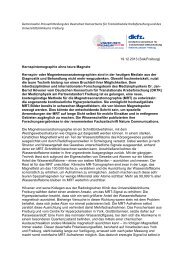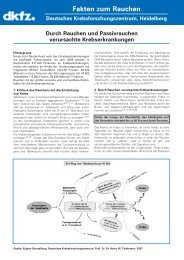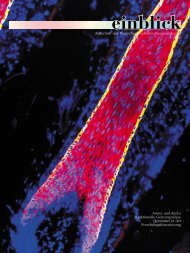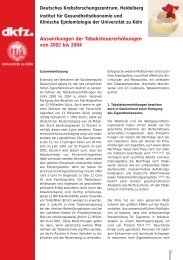MDCK-MRP2 - Dkfz
MDCK-MRP2 - Dkfz
MDCK-MRP2 - Dkfz
Erfolgreiche ePaper selbst erstellen
Machen Sie aus Ihren PDF Publikationen ein blätterbares Flipbook mit unserer einzigartigen Google optimierten e-Paper Software.
Forschungsschwerpunkt F<br />
Infektion und Krebs<br />
Bedeutung für die Persistenz und für das Entkommen von<br />
der Immunabwehr für diese Viren sein. Die Sequenzen einer<br />
zweiten Gruppe von 6 Isolaten waren in der genannten<br />
Region identisch miteinander, unterschieden sich aber darin,<br />
dass Punktmutationen im ORF1 zur Entstehung von neuen<br />
offenen Leserastern führen, die wiederum in der Entstehung<br />
von unterschiedlichen Proteinen resultieren sollten.<br />
Die Funktionen dieser neu-entstandenen Proteine werden<br />
weiter untersucht (Manuskript im Druck).<br />
Kombinations-Immunisierung gegen HPV 16 E7<br />
und HBs Antigen:<br />
Chimäre Konstrukte zwischen Hepatitis B Oberflächenantigen<br />
(s-Antigen) und dem HPV 16 Papillomvirus-Onkogen<br />
E7 wurden hergestellt und über Adeno- oder Herpes simplex<br />
Vektorsysteme auf ihre Expression in Gewebekultursystemen<br />
und auf ihre Immunogenität im Maussystem analysiert.<br />
Dabei zeigte sich, dass gegen beide Antigene effektiv<br />
Antikörperbildung, aber auch zell-vermittelte Immunreaktionen<br />
induziert werden können. Diese Versuche lassen<br />
erwarten, dass entsprechende Kombinationsimpfstoffe nach<br />
klinischer Prüfung auch beim Menschen sinnvoll eingesetzt<br />
werden können (Manuskript zum Druck eingereicht).<br />
Publikationen (* = externer Koautor)<br />
[1] Alpsoy E*, Ciftcioglu MA*, Keser I*, de Villiers E-M, Zouboulis<br />
CC*. (2002) Epidermodysplasia verruciformis associated with<br />
neurofibromatosis type 1: coincidental association or model for<br />
understanding the underlying mechanism of the disease? Br J<br />
Dermatol 146: 503 – 507.<br />
[2] Assaf C*, Steinhoff M*, Petrov I*, Geilen CC*, de Villiers E-<br />
M, Schultz-Ehrenburg U*, Orfanos CE*. (2004) Verrucous carcinoma<br />
of the axilla: case report and review. J Cutan Pathol.<br />
31:199-204.<br />
[3] Caldeira S, Zehbe I, Accardi R*, Malanchi I*, Dong W, Giarre<br />
M*, de Villiers E-M, Filotico R*, Boukamp P, Tommasino M. (2003)<br />
The E6 and E7 proteins of the cutaneous human papillomavirus<br />
type 38 display transforming properties. J Virol 77:2195-2206.<br />
[4] Cid-Arregui A, Juárez V*, zur Hausen H. (2003) A synthetic<br />
E7 gene of human papillomavirus type 16 that yields enhanced<br />
expression of the protein in mammalian cells and its application to<br />
DNA immunization studies. J Virol 77: 4928-4937.<br />
[5] Chamulitrat W, Schmidt R, Chunglok W, Kohl A*, Tomakidi P*.<br />
(2003) Epithelium and fibroblast-like phenotypes derived from<br />
HPV 16 E6/E7-immortalized human gingival keratinocates following<br />
chronic ethanol treatment. Eur J Cell Biol 82:313-322.<br />
[6] Chamulitrat W, Schmidt R, Tomakidi P*, Stremmel W*,<br />
Chunglok W, Kawahara T*, Rokutan K*. (2003) Association of<br />
gp91phox homolog Nox1 with anchorage-independent growth<br />
and MAP kinase-activation of transformed human keratinocytes.<br />
Oncogene 22: 6045-6053.<br />
[7] de Villiers E-M. (2003) Relationship between steroid hormone<br />
contraceptives and HPV, cervical intraepithelial neoplasia and<br />
cervical carcinoma. Int J Cancer 103: 705 – 708.<br />
[8] de Villiers E-M, Fauquet C*,Broker T*, Bernard H-U*, zur<br />
Hausen H. (2004) Classification of Papillomaviruses. Virology<br />
324: 17-27.<br />
[9] de Villiers E-M, Gunst K, Stein H*, Scherübl H*. (2004) Esophageal<br />
squamous cell cancer in patients with head and neck cancer:<br />
Prevalence of human papillomavirus DNA sequences. Int J<br />
Cancer (10.1002/ijc.11685) 109: 253-258.<br />
[10] de Villiers E-M, Sandstrom RE*, zur Hausen H, Buck CE*.<br />
Presence of papillomavirus sequences and absence of herpesvirus<br />
sequences in condylomatous lesions of the mamillae and in<br />
invasive carcinoma of the breast. (eingereicht)<br />
[11] de Villiers E-M, Schmidt R, Delius H, zur Hausen H. (2002)<br />
Heterogeneity of TT virus-like sequences isolated from human<br />
tumour biopsies. J Mol Med 80:44-50.<br />
Abteilung F070<br />
Tumorvirus-Charakterisierung<br />
[12] Fei J-W, Wei Q-X, Angel P, de Villiers E-M. Differential enhancement<br />
of a cutaneous HPV promoter by p63, Jun and mutant<br />
p53. (eingereicht)<br />
[13] Forslund O*, Antonsson A*, Higgins G*, Ly H*, Delius H,<br />
Hunziker A, de Villiers E-M. (2003) Nucleotide sequence and phylogenetic<br />
classification of candidate human papilloma virus type<br />
92. Virology 312: 255-260.<br />
[14] Jelcic I, Hotz-Wagenblatt A, Hunziker A, zur Hausen H, de<br />
Villiers E-M. (2004) Isolation of multiple genomes from a Hodgkin<br />
tumor: Genome reorganization within one TTV group and diversity<br />
in the hypervariable region of another group. (J Virol 78, im<br />
Druck)<br />
Buchbeiträge:<br />
[1] de Villiers E-M. (2004) Papillomviren. In: Die Infektiologie. D<br />
Adam, HW Doerr, H Link und H Lode (Hrsg) Springer Verlag pp.<br />
794-796.<br />
[2] de Villiers E-M, Bernard H-U*, Delius H, Broker T*, zur Hausen<br />
H. Papillomaviruses. In: Virus Taxonomy. 8th Report of the International<br />
Committee on Taxonomy of Viruses. Eds. A. Ball, CM<br />
Fauquet, et al., (im Druck)<br />
DKFZ 2004: Wissenschaftlicher Ergebnisbericht 2002 - 2003<br />
411

















